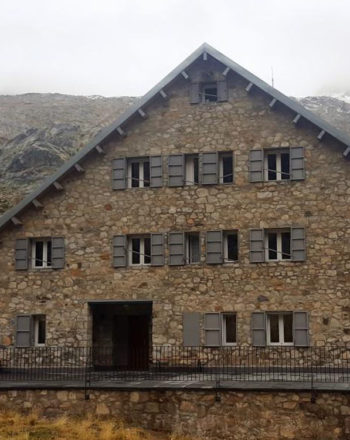Life SustainHuts
The LIFE SUSTAINHUTS project, which can be defined as Sustainable Huts, aims to modernize and optimize from the energy point of view 12 mountain huts from 4 European countries (Spain, Italy, Slovenia and France), with the target of reducing their pollutant emissions.

The energy modernization will consist in the optimization of energy management in the chosen mountain huts, improving the insulation and installing renewable energy based technologies, including a complete system of production, storage and use of renewable hydrogen in one of the Aragonese huts, Bachimaña. These actions aim to achieve an improvement in energy efficiency by 20%, a reduction of CO2 emissions in 10 tonnes and NOX (nitrogen oxides) in 0.06 tonnes per year and hut, and a reduction of about 15 helicopter trips per year required to supply the fuel, with an estimated saving of 1.5 tonnes per year of kerosene.
As result of the project, a series of methodological guides to replicate the solutions developed in the huts will be elaborated, so that the environmental improvements achieved can be replicated in the future to other locations, both within and outside the European borders.
The consortium is integrated by the following members: Foundation for the Development of New Hydrogen Technologies in Aragon (coordinator), Aragonese Mountaineering Federation (Spain), Italian Alpine Club Turin section (Italy), Environmental Park (Italy), Slovenia Mountain Partnership, Slovenia’s Hydrogen Technology Centre, University of Ljubljana (Slovenia) and the French Federation of Mountaineering & Alpine Clubs (France), who joined to the project after its beginning. Previously, the project counted on a Romanian partner, Transilvania University of Brașov, although they left the project after the first year of development.
Goals
- Creation of a resource assessment campaign adapted to extreme mountain conditions.
- Design and simulation of renewable installations considering different mountain environments.
- Design of a complete hydrogen cycle production based on renewable energy (production by electrolysis of water, pressurized storage, and power production by fuel cell).
- Reduction of the dependence from fossil fuels (diesel and propane gas).
- Selection and installation of new generation insulation materials.
- Implementation and demonstration tasks at 12 demo huts classified by altitude: 1 demo-hut at low altitude (<1.000 m), 3 demo-huts at medium altitude (1.000 m‑2.000 m), 7 demo-huts at high altitude (2.000 m‑3.000 m), and 1 demo-hut at extremely high altitude (>3.000 m).
- Life cycle assessment analysis aiming to determine environmental impacts of the new implemented technologies compared to present status.
- Extrapolation of results to other mountain areas.
- Impact at national and international scope.
Expected Results
The aim is to achieve a 20% improvement in energy efficiency, a reduction of CO2 (carbon dioxide) emissions of 10 tonnes per year and hut, as well as NOX (nitrogen oxides) in 0.06 tonnes per year and hut. It is also expected to reduce in up to 15 per year the helicopter flights required to supply the fuel to the huts, with an estimated saving of 1.5 tonnes per year of kerosene.
Actions
1.Preparatory actions
– Renewable resources. Permits and authorization
2.Purchase / lease of land (no actions in SUSTAINHUTS)
3.Implementation actions
– Renewable energy production
– Renewable hydrogen production
– Energy efficiency and new insulation materials
– Execution of demo-sites
– Life cycle assessment and environmental analysis
– Replicability and transferability of results
– Guidelines and methodologies to achieve SUSTAINHUTS
4.Monitoring of the impact of the Project actions
– Monitoring of the impact of Project actions
– Evaluation of socio-economic impact
5.Communication and dissemination of results
– Dissemination and awareness plan (DAP) development and update
– Specific activities for DAP execution
6.Project management
– Project management by FHA
– After LIFE communication and conservation plan




